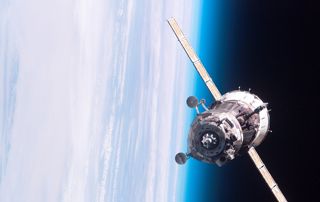
Soyuz – The Queen Of Spacecraft
- 10th May 2017
- Author: Tamela Maciel
The first thing you see when you walk through the doors at the National Space Centre is Soyuz.
This Soviet-era spacecraft has been the workhorse of the Russian spaceflight programme since the 1960s and is currently the only way that international astronauts can travel into space. What’s remarkable about Soyuz is how little has actually changed between the 1960s-era Soyuz, which graces our entrance, and the Soyuz of today that ferries astronauts such as Tim Peake to and from the International Space Station.
As the saying goes, ‘if it ain’t broke, don’t fix it’, and Soyuz has proven itself to be the most reliable spacecraft in history.
Soyuz past and present
During the Space Race of the 1960s, the United States and the Soviet Union raced to be the first to send a person into space, and when the Soviet Union got there first, they raced to be the first to land someone on the Moon. This required the rapid development of spacecraft that could carry multiple people into space for long periods of time.
NASA created Mercury, Gemini, and finally the Apollo spacecraft that carried men to the Moon.
The Soviet Union created Vostok, Soyuz, and Zond, a stripped-down version of Soyuz designed to circle the Moon.
So Soyuz and Gemini can be thought of as siblings in the Space Race. Both were designed to carry multiple astronauts into space and to test out activities such as rendezvous, docking, and multi-day missions in orbit around the Earth, all essential tasks to get to the Moon.
But unlike Gemini, the Soyuz spacecraft (and its identically-named rocket) is still going, more than 50 years since its first flight. After early technical problems and the tragic in-flight fatalities of Soyuz 1 in 1967 and Soyuz 11 in 1971, the Soyuz spacecraft and rocket has since proven itself to be the world’s most frequently used and most reliable means of getting to space. And since 2011, when the NASA Space Shuttle retired, Soyuz has been the only way of getting humans into space. Soyuz has carried British astronauts Helen Sharman (in 1991), Michael Foale (in 2003/2004), and Tim Peake (in 2015/2016) on their respective space missions.
The early Space Race engineers of Soyuz probably never imagined it would have such a legacy!
Soyuz in Leicester
The Soyuz at the National Space Centre is the oldest, most complete Soyuz spacecraft on display in the Western World. It dates from 1967-1971 and it’s officially known as a ‘Soyuz 7K-OK’, which is the same type as the first Soyuz ever flown. Our Soyuz is unusual in that it’s displayed with all three parts: the conical descent module, the spherical orbital module, and the cylindrical service module.
This immediately gives away the fact that our Soyuz has never flown in space. If it had, the orbital module and the service module would have been discarded and burnt up in Earth’s atmosphere on descent.
The descent module is designed for astronauts to sit in during both launch and re-entry. It’s the only part of the Soyuz spacecraft that returns to Earth, hence it is the descent module of Tim Peake’s mission that’s currently on display at the Science Museum in London. People are always amazed to realise that the Soyuz descent module carries three astronauts inside, fully suited and squeezed into custom launch seats. Conditions are very cramped and astronauts can be in there for more than six hours!
The orbital module is designed to offer additional living space and room for cargo, including a space toilet. It allows the astronauts to stretch out a bit if they spend time orbiting Earth before docking to a space station.
The service module contains the electronics and fuel tanks for propulsion in space. Twin, foldable solar panels are also attached to the service module.
Is our Soyuz real?
Yes! Well, mostly. The descent and service modules are definitely real, based on the materials used and internal wiring and insulation. They appear to have come off the factory production line in the late 1960s and for whatever reason, they weren’t fully kitted out inside for flight. Instead these two sections were later bolted on to a less-complete orbital module and the full Soyuz was placed on display as a model outside a factory in Georgia (formally part of the Soviet Union).
In the late 1990s, the National Space Centre was looking for a crowning space artefact to complete its collection before opening to the public in 2001. As luck would have it, the Soyuz on display in Georgia was for sale, but in need of some tender loving care after its years exposed to the elements.
It was shipped to the UK in November 2000 and restoration work soon revealed the original paintwork of a Soviet flag and the letters ‘CCCP’ and ‘USSR’ on the descent module, underneath several layers of paint. The orbital module had to be repainted entirely, and mock solar panels were added to complete the look.
About the author: Dr Tamela Maciel is the Space Communications Manager at the National Space Centre.





